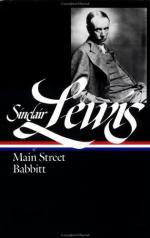Though they had all been certain that they longed for the privilege of attending committee meetings and rehearsals, the dramatic association as definitely formed consisted only of Kennicott, Carol, Guy Pollock, Vida Sherwin, Ella Stowbody, the Harry Haydocks, the Dave Dyers, Raymie Wutherspoon, Dr. Terry Gould, and four new candidates: flirtatious Rita Simons, Dr. and Mrs. Harvey Dillon and Myrtle Cass, an uncomely but intense girl of nineteen. Of these fifteen only seven came to the first meeting. The rest telephoned their unparalleled regrets and engagements and illnesses, and announced that they would be present at all other meetings through eternity.
Carol was made president and director.
She had added the Dillons. Despite Kennicott’s apprehension the dentist and his wife had not been taken up by the Westlakes but had remained as definitely outside really smart society as Willis Woodford, who was teller, bookkeeper, and janitor in Stowbody’s bank. Carol had noted Mrs. Dillon dragging past the house during a bridge of the Jolly Seventeen, looking in with pathetic lips at the splendor of the accepted. She impulsively invited the Dillons to the dramatic association meeting, and when Kennicott was brusque to them she was unusually cordial, and felt virtuous.
That self-approval balanced her disappointment at the smallness of the meeting, and her embarrassment during Raymie Wutherspoon’s repetitions of “The stage needs uplifting,” and “I believe that there are great lessons in some plays.”
Ella Stowbody, who was a professional, having studied elocution in Milwaukee, disapproved of Carol’s enthusiasm for recent plays. Miss Stowbody expressed the fundamental principle of the American drama: the only way to be artistic is to present Shakespeare. As no one listened to her she sat back and looked like Lady Macbeth.
III
The Little Theaters, which were to give piquancy to American drama three or four years later, were only in embryo. But of this fast coming revolt Carol had premonitions. She knew from some lost magazine article that in Dublin were innovators called The Irish Players. She knew confusedly that a man named Gordon Craig had painted scenery—or had he written plays? She felt that in the turbulence of the drama she was discovering a history more important than the commonplace chronicles which dealt with senators and their pompous puerilities. She had a sensation of familiarity; a dream of sitting in a Brussels cafe and going afterward to a tiny gay theater under a cathedral wall.
The advertisement in the Minneapolis paper leaped from the page to her eyes:
The Cosmos School of Music, Oratory, and Dramatic Art announces a program of four one-act plays by Schnitzler, Shaw, Yeats, and Lord Dunsany.
She had to be there! She begged Kennicott to “run down to the Cities” with her.




